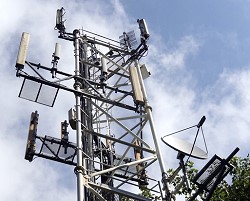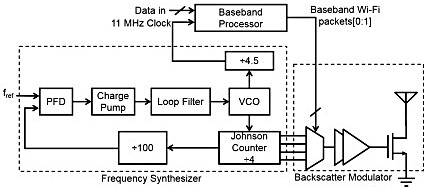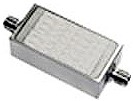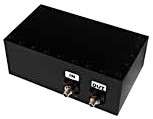Anatech Electronics Newsletter - August 2016 |
|
Anatech Electronics, a manufacturer of RF and microwave filters, has published its August 2016 newsletter. As always, it includes both company news and some tidbits about relevant industry happenings. This month, Sam Benzacar discusses the topics of "IoT Connectivity: The Next Interference Challenge," Facebook's OpenCellular, Passive WiFi, and "AT&T Dreams BIG." Anatech's business is to make certain that system and circuit designers have capable filters available to assure successful implementation. IoT Connectivity: The Next Interference Challenge
If you've been following the run-up to the unveiling of 5G, you may have noticed how much attention is being paid to the Internet of Things (IoT) within the latest wireless standards. As we've all heard too many times to count, IoT will ultimately result in billions of little sensor-enabled devices that will ultimately change the world as we know it. Unfortunately, there's been little evidence of this actually happening, other than in home automation and Internet-connected refrigerators with flat-panel displays and internal cameras that let us see what's inside from anywhere from a smartphone app. However, IoT is actually happening – it's just hard to find because rather than getting started in the consumer world, it's first inroads have been in industrial applications that are a lot less visible.
To replace them, the wireless industry is baking IoT-specific (that is, low-power narrowband) specifications into its standards for the first time, the first of which are in Release 13, which was finalized this month. As AT&T, Verizon, T-Mobile, Sprint, and the rest already have the required infrastructure that requires only minimal modifications, logic would dictate there's no need for any other solutions. However, the plot thickens. Low-power wireless area networks (LPWANs) are being installed throughout the U.S. and elsewhere by companies competing with the wireless carriers to grab some of this potentially enormous market. Each approach is different but they're all designed specifically to meet the needs of IoT connectivity, which are less demanding than their high-speed, broadband counterparts. The goal is to have as much infrastructure in place in as many places as possible to present a compelling alternative to what the wireless carriers will ultimately be offering. How this will eventually play out is impossible to say but one thing is certain: interference will be a concern, even though they operate at very low power levels with narrow signal bandwidths. The sheer number of IoT devices sending and receiving data on these networks (and for that matter on the cellular versions as well) offers at least the potential for interference problems to occur. And as always, the best way to keep this from happening is proper filtering, something Anatech Electronics has been providing for more than 25 years. We offer RF and microwave solutions for every licensed and unlicensed band that will be used to connect IoT devices, as well as the resources to solve any interference problem you'll encounter. So if you're designing IoT connectivity solutions, we're here to help. Just give us at a call at ((73) 772-4242 or send us an email to sales@anatechelectronics.com. What's News Facebook's OpenCellular
What is Passive Wi-Fi?
Our experimental evaluation shows that passive Wi-Fi transmissions can be decoded on off-the-shelf smartphones and Wi-Fi chipsets over distances of 30 - 100 feet in various line-of-sight and through-the-wall scenarios. Finally, we design a Passive Wi-Fi IC that shows that 1 and 11~Mbps transmissions consume 14.5 and 59.2 µW respectively. This translates to 10000x lower power than existing Wi-Fi chipsets and 1000x lower power than Bluetooth LE and ZigBee. The Obama Administration recently announced a $400 million initiative led by the National Science Foundation that will conduct research in the area of 5G wireless technology which promises to be up to 100 times faster than today's 4G LTE. The Advanced Wireless Research Initiative (AWRI), which builds on the Federal Communications Commission's recent Spectrum Frontiers vote, will deploy four city-scale testing platforms over the next decade that will be used for advanced wireless research. Each platform will be comprised of a network of software-defined radio antennas blanketing their respective cities, essentially mimicking existing cellular networks. The White House says this will allow academic researchers, entrepreneurs and wireless companies to test, prove and refine their technologies and software algorithms in a real-world setting. The cities, which haven't yet been named, will be selected based on open competition, the administration said. Yesterday's FCC vote made the US the first country in the world to free up large quantities of high-frequency millimeter wave spectrum for both licensed and unlicensed use. The White House also said that more than 20 US-based private-sector companies and associations including AT&T, HTC, Intel, Juniper Networks, Nokia, Qualcomm, Samsung, Sprint, T-Mobile and Verizon have collectively pledged over $35 million to support the design, development, deployment and ongoing operations of the aforementioned testing platforms. It's more than just financial backing, however, as the entities will also provide design support, technical networking expertise, networking hardware, software-defined networking switches and routers, cloud computing, experimental handsets and devices, servers and more. More information on the initiative can be found in the White House's lengthy press release. You can also learn more about the FCC's recent vote by clicking here. AT&T Dreams BIG AT&T has big dreams for its new national drone program, including the use of UAVs to provide LTE coverage in crowded or remote locations. In a blog post by company Chief Strategy Officer John Donovan, he said AT&T is expecting many "different drone uses in the future." The carrier envisions using tethered drones for big events like music festivals, since a huge gathering of people tend to congest networks. However, these "Flying Cell on Wings," as Donovan called them, could also be deployed to disaster areas in order to provide survivors the connection they need to contact family and friends as soon as possible. Donovan admits that drone-based LTE network isn't quite a reality yet, but the company has begun working towards that goal. Ma Bell has launched its national drone program's trial phase in San Francisco, where it demoed how it uses UAVs to inspect its cell towers. In addition to finding out how it can use drones to provide mobile internet, AT&T is also researching how they can tap into its LTE network to send and receive large amounts of data for commercial purposes. It will mostly likely take some time before you see signal-boosting flying machines at Coachella, though, so you'll probably still have to deal with failed Instagram uploads next year. Check out Our Filter Products
About Anatech Electronics Anatech Electronics, Inc. (AEI) specializes in the design and manufacture of standard and custom RF and microwave filters and other passive components and subsystems employed in commercial, industrial, and aerospace and applications. Products are available from an operating frequency range of 10 kHz to 30 GHz and include cavity, ceramic, crystal, LC, and surface acoustic wave (SAW), as well as power combiners/dividers, duplexers and diplexers, directional couplers, terminations, attenuators, circulators, EMI filters, and lightning arrestors. The company's custom products and capabilities are available at www.anatechelectronics.com. Contact: Anatech Electronics, Inc.
Posted August 18, 2016 |

 By Sam Benzacar
By Sam Benzacar All of these IoT devices have to communicate with each other and
the outside world. Locally, this can be accomplished by ZigBee or Bluetooth but to extend further requires
greater reach. So more than likely each one will be connected directly to a wireless network, which
today are wireless carriers' 2G resources, but not for much longer: They'll all be turned off by December
31, the end of the so-called "2G Sunset", as they're no longer needed.
All of these IoT devices have to communicate with each other and
the outside world. Locally, this can be accomplished by ZigBee or Bluetooth but to extend further requires
greater reach. So more than likely each one will be connected directly to a wireless network, which
today are wireless carriers' 2G resources, but not for much longer: They'll all be turned off by December
31, the end of the so-called "2G Sunset", as they're no longer needed. Facebook has designed and
tested an open-source software-defined wireless access platform called OpenCellular designed for use
in remote areas of the world. It can support communication options from a network in a box to an access
point supporting standards ranging from 2G to 4G (LTE). It consists of two main subsystems: general-purpose
and baseband computing with integrated power and housekeeping system, and an RF subsystem including
an analog front end. The company's goal is to make the design, firmware, and control software available
to any developers so they can build, deploy, and operate an inexpensive wireless network. Facebook will
work with Telecom Infra Project (TIP) members to establish an open source community and to select trial
locations to validation all aspects of the system.
Facebook has designed and
tested an open-source software-defined wireless access platform called OpenCellular designed for use
in remote areas of the world. It can support communication options from a network in a box to an access
point supporting standards ranging from 2G to 4G (LTE). It consists of two main subsystems: general-purpose
and baseband computing with integrated power and housekeeping system, and an RF subsystem including
an analog front end. The company's goal is to make the design, firmware, and control software available
to any developers so they can build, deploy, and operate an inexpensive wireless network. Facebook will
work with Telecom Infra Project (TIP) members to establish an open source community and to select trial
locations to validation all aspects of the system. Computer Science & Engineering Department of the University
of Washington has demonstrated a passive Wi-Fi system that can operate using the 802.11b standard using
backscatter communication, while consuming 3 - 4 orders of magnitude lower power than existing Wi-Fi
chipsets. Passive Wi-Fi transmissions can be decoded on any Wi-Fi device including routers, mobile phones
and tablets. Building on this, we also present a network stack design that enables Passive Wi-Fi transmitters
to coexist with other devices in the ISM band, without incurring the power consumption of carrier sense
and medium access control operations. We build prototype hardware and implement all four 802.11b bit
rates on an FPGA platform.
Computer Science & Engineering Department of the University
of Washington has demonstrated a passive Wi-Fi system that can operate using the 802.11b standard using
backscatter communication, while consuming 3 - 4 orders of magnitude lower power than existing Wi-Fi
chipsets. Passive Wi-Fi transmissions can be decoded on any Wi-Fi device including routers, mobile phones
and tablets. Building on this, we also present a network stack design that enables Passive Wi-Fi transmitters
to coexist with other devices in the ISM band, without incurring the power consumption of carrier sense
and medium access control operations. We build prototype hardware and implement all four 802.11b bit
rates on an FPGA platform. 
